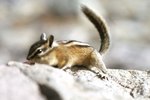Caring for orphaned baby mice is not easy; many infant mice don't make it through the first week due to heat loss, lack of nutrition or sickness. If the baby mouse is a pinkie; that is, without any fur, raising him to adulthood is difficult, but not impossible. With feedings every one to two hours and plenty of warmth, he has a decent chance of survival.
Supplies to Have on Hand
Being prepared is the first step in the successful raising of an orphaned baby mouse. Items to have on hand include Pedialyte, a small syringe, a heating pad or hot water bottle and soft nesting material such as old T-shirts, blankets and small stuffed animals. Puppy milk replacement, found at most pet food stores, is also important, as this is the closest option to mouse milk available.
Where to Start
Inspect the baby mouse first for any wounds or signs of illness such as blood around the nose, or labored breathing. You also will need to stimulate the baby mouse to go to the bathroom; he cannot do this on his own. Mimic the mother's natural way of licking his genitals by using a damp cotton swap, or the tip of your finger. You will need to do this after every feeding until the baby mouse is able to void on his own.
Full Bellies Are Important
Feed the baby mouse by filling a small 1 cubic centimeter syringe with puppy milk replacement and slowly administering it into his mouth. Be careful not to press too hard on the syringe or the mouse will aspirate; you will see milk come from his nose. Position the baby mouse upright and belly down for his feedings. For the first three feedings, dilute the puppy milk replacement with a little water and watch for diarrhea. If the stools are mustard yellow, everything is normal.
Warm Nests Make Happy Babies
When using a heating pad for your baby mouse, never place the mouse directly on the pad and always keep the pad setting on low. A too-warm pad can dehydrate a baby mouse quickly. If he has other orphaned siblings, keep all the baby mice together and ensure one does not wander off on his own. Fill the mouse's enclosure with plenty of bedding, both under and above the baby mouse. Do not cover the mouse in an airtight container, but do keep him under wraps to trap heat.
Tips and Tricks
Warm the formula for the baby mouse by placing it in warm tap water for a few minutes. The baby mouse will indicate when it is full, but a helpful trick for expected formula amounts is to weigh him first. The mouse's weight in grams, divided in half, equals the amount of cc's he should be eating. If the mouse refuses to drink, try using Pedialyte before attempting formula again.
References
- The Fun Mouse: Orphaned Mice
- Rat and Mouse Club of America: Orphaned Rats and Mice
- Rat Fan Club: Raising Orphaned Rats and Mice
- Fancy Mice: Baby Care
- The Complete Care of Baby Animals: Expert Advice on Raising Orphaned, Adopted or Newly Bought Kittens, Puppies, Foals, Lambs, Chicks and More; C. E. Spaulding, Jackie Clay
Photo Credits
-
bozhdb/iStock/Getty Images




